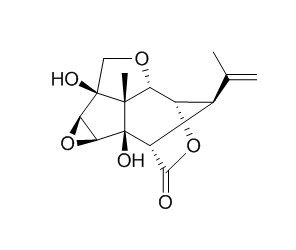Corianin
Corianin and coriatin demonstrate synergistic effect to insecticidal activity of tutin againstarmyworm.
Inquire / Order:
manager@chemfaces.com
Technical Inquiries:
service@chemfaces.com
Tel:
+86-27-84237783
Fax:
+86-27-84254680
Address:
1 Building, No. 83, CheCheng Rd., Wuhan Economic and Technological Development Zone, Wuhan, Hubei 430056, PRC
Providing storage is as stated on the product vial and the vial is kept tightly sealed, the product can be stored for up to
24 months(2-8C).
Wherever possible, you should prepare and use solutions on the same day. However, if you need to make up stock solutions in advance, we recommend that you store the solution as aliquots in tightly sealed vials at -20C. Generally, these will be useable for up to two weeks. Before use, and prior to opening the vial we recommend that you allow your product to equilibrate to room temperature for at least 1 hour.
Need more advice on solubility, usage and handling? Please email to: service@chemfaces.com
The packaging of the product may have turned upside down during transportation, resulting in the natural compounds adhering to the neck or cap of the vial. take the vial out of its packaging and gently shake to let the compounds fall to the bottom of the vial. for liquid products, centrifuge at 200-500 RPM to gather the liquid at the bottom of the vial. try to avoid loss or contamination during handling.
Antioxidants (Basel).2021, 10(3):379.
Chulalongkorn University2024, 4761190
Industrial Crops and Products2022, 186:115298
Life Sci.2018, 209:498-506
BMC Complement Altern Med.2014, 14:242
Food Chem Toxicol.2024, 186:114589.
Antioxidants (Basel).2021, 10(9):1487.
Biomed Chromatogr.2019, 8:e4774
Int J Mol Sci.2023, 24(18):14077.
J Biomed Sci.2020, 27(1):60.
Related and Featured Products
Am J Chin Med. 2014;42(1):23-35.
Phytochemistry and biology of Loranthus parasiticus Merr, a commonly used herbal medicine.[Pubmed:
24467533]
Loranthus parasiticus Merr (L. parasiticus) is a member of Loranthaceae family and is an important medicinal plant with a long history of Chinese traditional use. L. parasiticus, also known as Sang Ji Sheng (in Chinese), benalu teh (in Malay) and baso-kisei (in Japanese), is a semiparasitic plant, which is mostly distributed in the southern and southwestern regions of China.
METHODS AND RESULTS:
This review aims to provide a comprehensive overview of the ethnomedicinal use, phytochemistry and pharmacological activity of L. parasiticus and to highlight the needs for further investigation and greater global development of the plant's medicinal properties. To date, pharmacological studies have demonstrated significant biological activities, which support the traditional use of the plant as a neuroprotective, tranquilizing, anticancer, immunomodulatory, antiviral, diuretic and hypotensive agent. In addition, studies have identified antioxidative, antimutagenic, antiviral, antihepatotoxic and antinephrotoxic activity. The key bioactive constituents in L. parasiticus include coriaria lactone comprised of sesquiterpene lactones: coriamyrtin, tutin, Corianin, and coriatin. In addition, two proanthocyanidins, namely, AC trimer and (+)-catechin, have been recently discovered as novel to L. parasiticus.
CONCLUSIONS:
L. parasiticus usefulness as a medicinal plant with current widespread traditional use warrants further research, clinical trials and product development to fully exploit its medicinal value.
Journal of Northwest Forestry University, 2014, 29(1):105-10.
The Preliminary Study on Pesticidal Activity of Main Components in Coriaria Lactone.[Reference:
WebLink]
METHODS AND RESULTS:
Toxic symptom and contact poisoning activity of tutin,coriatin and Corianin were observed on the larvae of Mythimna separata with 3,4,5and 6instars by leaf disk method and dripping method.The results showed that the poisoning symptoms for tutin included slow in action,coma,recovery,paralysis,and dehydration on body surface,but the symptoms did not appear by using coriatin and Corianin.After treated by different proportions(1∶3,1∶1,3∶1)of tutin and coriatin,larvae with 3,4,5instars demonstrated the symptom of coma with various degrees,and the largest number of coma was 4instars,and the coma disappeared in 6instars.Different proportions of tutin and Corianin caused a decreased number of coma symptom in the larvae with 3,and 4instars,and partial coma in 6instars.Direct dripping different concentrations of tuin to each instars insect demonstrated poisoning actions,concentration 1.00mg·mL-1 exhibited the strongest poisoning effect.Different ratios of tuin and coriatin,tuin and Corianin on armyworm had significant influence on appetite and cumulative mortality rates,along with the increase of coriatin and Corianin, the impact on armyworm food intake and cumulative mortality was more significant.
CONCLUSIONS:
It was preliminarily concluded that coriatin and Corianin demonstrated synergistic effect to insecticidal activity of tutin againstarmyworm.



